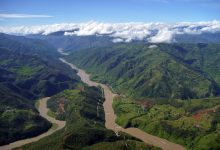The deepest river in the world is the Congo River, located in Africa. Spanning a length of approximately 4,700 kilometers (2,920 miles), the Congo River is not only one of the longest rivers globally but also holds the distinction of being the deepest. Its maximum depth reaches an astounding 220 meters (720 feet) in certain parts, making it a significant hydrological feature on the African continent. The Congo River plays a vital role in the region’s ecosystem, serving as a crucial waterway for transportation, supporting diverse wildlife, and sustaining local communities through fishing and agriculture along its banks. Additionally, the river’s basin is one of the largest in the world, covering an expansive area of approximately 4 million square kilometers (1.5 million square miles) across multiple countries, including the Democratic Republic of the Congo, Republic of the Congo, Central African Republic, Angola, Zambia, Tanzania, and Cameroon. This vast drainage basin contributes to the Congo River’s impressive volume and depth, as it collects water from numerous tributaries and rainfall within its expansive catchment area. With its immense depth and significance to the African continent, the Congo River stands as a natural wonder and a critical resource for millions of people living in its vicinity.
More Informations

The Congo River, often referred to as the “heart of Africa,” is a colossal waterway that traverses through the heart of the continent, shaping landscapes, ecosystems, and human societies along its course. Originating from the highlands and plateaus of the East African Rift, specifically from the mountainous region of the East African Great Lakes, the Congo River flows westward, eventually emptying into the Atlantic Ocean. Its journey takes it through a diverse range of environments, including dense rainforests, expansive savannas, and marshy swamps, each contributing to the river’s unique character and ecological significance.
One of the defining features of the Congo River is its remarkable depth, which sets it apart as the deepest river globally. While the exact measurement of its depth can vary along different stretches, certain parts of the river reach depths of up to 220 meters (720 feet). This extraordinary depth is attributed to various factors, including the river’s geological history, the underlying bedrock, and the erosive forces of water over millennia. As the river meanders through rugged terrain and geological formations, it has carved deep channels and gorges, creating a complex network of underwater canyons and basins.
The Congo River Basin, encompassing an area of approximately 4 million square kilometers (1.5 million square miles), is one of the largest drainage basins in the world. This vast expanse collects water from numerous tributaries, streams, and rainfall within its catchment area, contributing to the river’s impressive volume and depth. Some of the major tributaries that feed into the Congo River include the Kasai, Ubangi, Sangha, and Lualaba rivers, each adding to the overall flow and hydrological dynamics of the system.
Beyond its geological and hydrological significance, the Congo River plays a pivotal role in supporting rich biodiversity and sustaining livelihoods for millions of people in the region. The river and its surrounding ecosystems are home to an incredibly diverse array of flora and fauna, including iconic species such as the African elephant, hippopotamus, and numerous fish species found nowhere else on Earth. Additionally, the Congo Basin rainforest, which the river helps to irrigate and nourish, is considered one of the world’s most biodiverse regions, supporting countless plant and animal species, many of which are still being discovered and studied by scientists.
In addition to its ecological importance, the Congo River serves as a vital lifeline for human communities living along its banks. For centuries, indigenous peoples have relied on the river for transportation, trade, fishing, and agriculture, with many settlements and cities flourishing along its shores. Today, the Congo River continues to be a crucial artery for commerce and travel, facilitating the movement of goods and people across vast distances within the continent.
However, despite its immense natural wealth and cultural significance, the Congo River and its surrounding ecosystems face numerous threats, including deforestation, pollution, habitat degradation, and unsustainable exploitation of natural resources. Human activities such as mining, logging, and agricultural expansion have taken a toll on the river’s health and resilience, jeopardizing the delicate balance of its ecosystems and the well-being of local communities.
Efforts are underway to address these challenges and promote sustainable management practices that safeguard the Congo River’s ecological integrity while supporting the livelihoods of those who depend on it. Conservation initiatives, such as protected areas, community-based resource management, and international collaborations, are helping to mitigate the impacts of human activities and preserve the river’s unique biodiversity for future generations.
In conclusion, the Congo River stands as a testament to the power and complexity of nature, weaving together geological, ecological, and cultural dimensions into a majestic waterway that sustains life across the African continent. Its status as the deepest river in the world underscores its significance as a natural wonder and underscores the importance of conserving and managing this invaluable resource for the benefit of both present and future generations.

